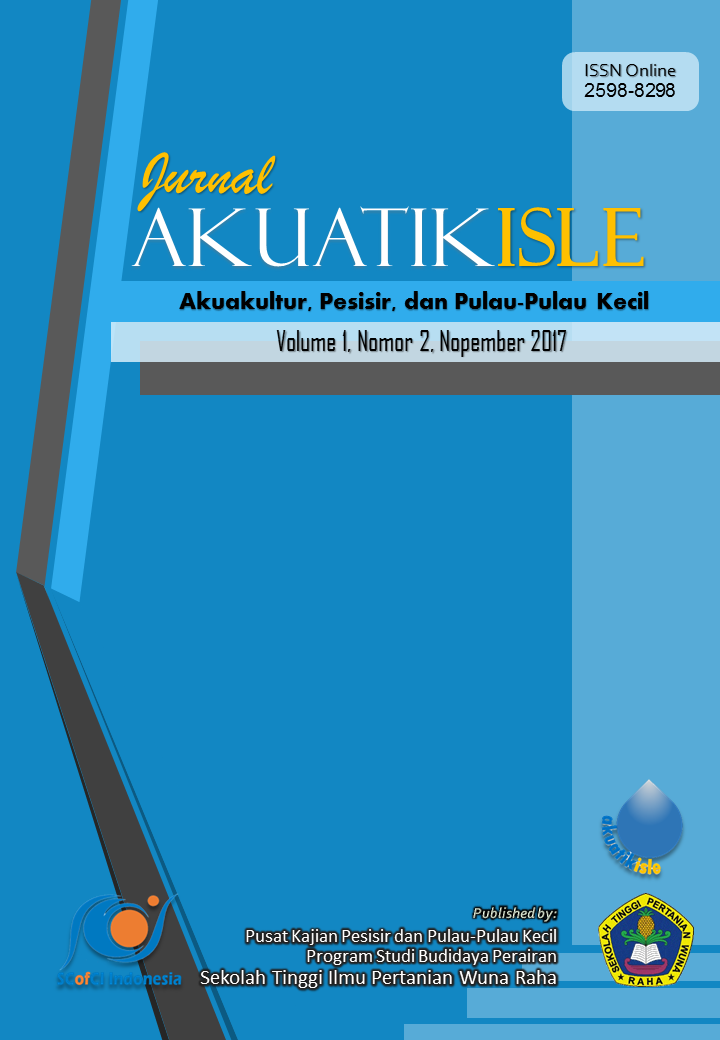Akuatikisle: Jurnal Akuakultur, Pesisir dan Pulau-Pulau Kecil
Full Length Article
Study of suitability waters location for seaweed culture in Muna Regency, Indonesia
Highlights
Generate NLP AI by Wizdam ID.
Abstract
The research aims to determine the location of cultivation at various levels of suitability and identify physical and chemical conditions in the location of seaweed cultivation in the Muna Regency. The study was conducted in June 2018 in 4 (four) stations which are coastal areas of Muna Regency, namely Marobo Village Marobo District (Station 1), Komba-Komba Village Kabangka District (Station 2), Lasunapa Village Duruka District (Station 3), and Bahari Village Towea District (Station 4). Observation and measurement and sampling were carried out at three different locations, namely observation point 1 (a location that was never planted seaweed), observation point 2 (former location of seaweed cultivation), and observation point 3 (location of seaweed cultivation). The results showed that the location of waters for seaweed cultivation in the Muna Regency consisted of appropriate and less appropriate criteria based on the value of the evaluation results of the suitability of the location of waters for seaweed cultivation. These criteria are scattered at each station's observation points. All physical and chemical parameters of the waters in the land suitability criteria become a limiting factor for seaweed growth, at each observation point that is different at each station. All types of seaweed (algae) can live in the waters of Muna Regency, where seaweed species Eucheuma cottonii, Eucheuma spinosum, and Gracilaria sp. are types that are already common in cultivation, and Eucheuma cottonii and Eucheuma spinosum are types that are already popular in seaweed cultivation activists in Muna Regency
Keywords
Introduction
Section snippets
Material and Methods
Materials and methods from the full-text PDF of this article cannot be displayed.
Results
Results from the full-text PDF of this article cannot be displayed.
Discussion
Discussion from the full-text PDF of this article cannot be displayed.
Conclusions
Conclusions from the full-text PDF of this article cannot be displayed.
Acknowledgment
Acknowledgment from the full-text PDF of this article cannot be displayed.
Competing interest
The authors declare that they have no known competing financial interests or personal relationships that could have appeared to influence the work reported in this paper.
Conflict of interest
The authors declare that the research was conducted in the absence of any commercial or financial relationships that could be construed as a potential conflict of interest.
Ethical approval acknowledgements
No ethical approval required for this article. All procedures followed were in accordance with the ethical standards of the responsible committee on human experimentation (institutional and national) and with the Helsinki Declaration of 1975, as revised in 2008 (5)
Supplementary files
Data sharing not applicable to this article as no datasets were generated or analysed during the current study, and/or contains supplementary material, which is available to authorized users.
Bibliographic Information
Cite this article as:
-
Submitted
14 September 2017 -
Revised
30 September 2017 -
Accepted
12 October 2017 -
Published
17 November 2017 -
Version of record
3 December 2017 -
Issue date
21 November 2017
-
Academic subject
Aquaculture; Fisheries Science
Copyright
Cultivation is needed to encourage people's economic activities, but is not limited to export commodities such as shrimp. Because it requires a variety of commodities. There are many other commodities that need to be developed, one of which is seaweed. Archipelago areas need to determine the location of cultivation at various levels of suitability and identify their characteristics (physical and chemical).
Copyright © 2017 Sitti Sasrani Mutrono Gufana, Fendi, Karyawati, & Abbas Sommeng. Sangia Research Media and Publishing. Production and hosting by Sangia (SRM™).  This work is licensed under a Creative Commons Attribution-ShareAlike 4.0 International License.
This work is licensed under a Creative Commons Attribution-ShareAlike 4.0 International License.
Disclaimer: All claims expressed in this article are solely those of the authors and do not necessarily represent those of their affiliated organizations, or those of the publisher, the editors and the reviewers. Any product that may be evaluated in this article or claim that may be made by its manufacturer is not guaranteed or endorsed by the publisher.
Comments on this article
By submitting a comment you agree to abide by our Terms and Community Guidelines. If you find something abusive or that does not comply with our terms or guidelines please flag it as inappropriate.


